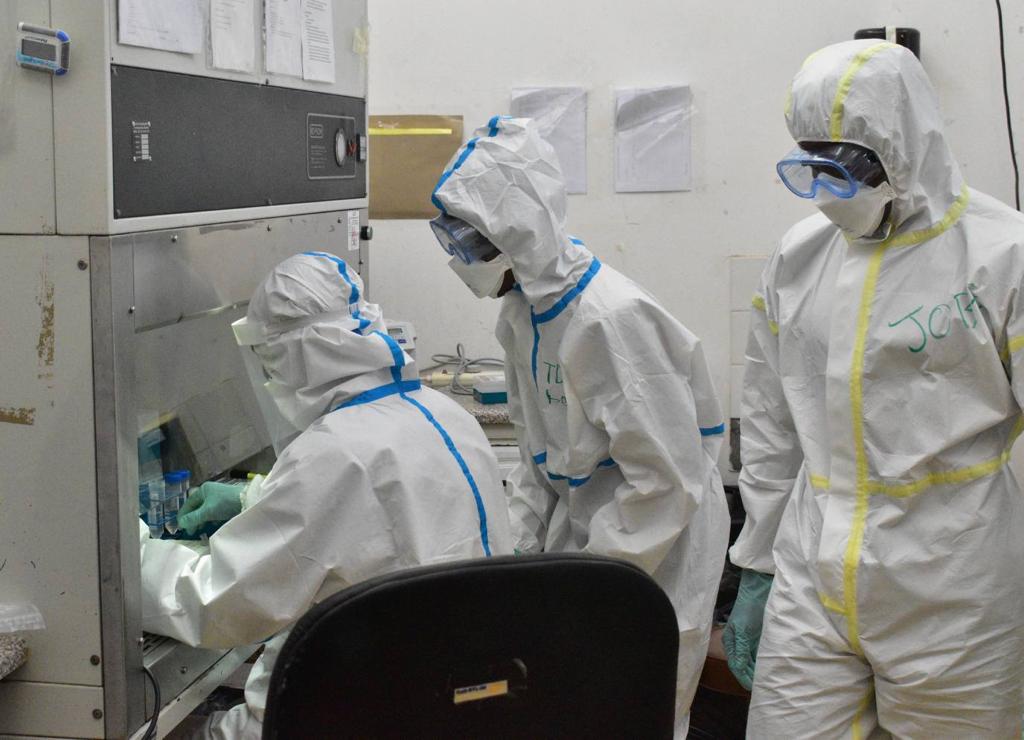The slow pace at which tests for COVID-19 samples are being done at the National Tuberculosis Reference Laboratory (NTBRL) at Mpilo Central Hospital in Bulawayo has been attributed to lack of adequate machinery and working space at the health facility, officials have said.
The facility is a specialised TB testing centre and now doubles as a COVID-19 testing facility forcing teams to work in shifts.
In the morning TB tests are processed and then in the afternoon, they run COVID-19 samples.
The lab uses the Polymerase Chain Reaction (PCR) machine to run COVID-19 which takes up to five hours before a result is produced.
According to officials, PCR testing requires a lot of chemicals and if people were made to pay, an individual would pay no less than US$100 but now the service is free, as it is a government programme.
Mpilo started testing for coronavirus last week as part of efforts to scale up the number of COVID-19 tests in the country, which was only done at the National Reference Laboratory at Sally Mugabe Hospital in Harare.
As of April 20, the country has tested a total of 3 308 COVID-19 tests.
Last Friday, Head of Applied Genetics Testing Centre, Zephaniah Dlamini from the National University of Science and Technology (NUST), which partnered with Mpilo to conduct the COVID-19 tests explained to journalists how the testing procedure works.
Dlamini said since the national laboratory at Mpilo was for TB and there were a lot of samples that had to be tested and hence it delayed their testing for COVID-19.
“What we usually do is to say the TB people work in the morning, then we start COVID-19 in the afternoon to give the clinicians time to bring the samples as well,” said the expert.
He added that they also started testing in the afternoon so that samples from other places can be delivered to the laboratory in time.
“We don’t want to start at 8 am when people have worn the Personal Protective Equipment (PPE), which are disposable then at 10 am someone brings another sample, which means workers have to wear more PPE again. We start in the afternoon and depending on the increase in volumes, it will mean we will be spending the nights here,” Dlamini said.
Dlamini said so far, the laboratory was testing 25 to 30 samples on average a day.
“The timeline is made in such a way that we receive phone calls from other places to say we are going to bring samples. Because a testing plate represents 96 samples, we would like to batch the samples as much as possible so we don’t waste the plate. This means we have to wait for the samples that are coming in. If they come early enough when we are starting our run, we then incorporate those in that run,” he said.
The expert explained the PCR machine used to test for coronavirus was effective, as it detected COVID-19 in real time.
“We take samples from the nose, then extract the RNA from the person. (RNA is short for ribonucleic acid, which is nucleic acid used in key metabolic processes for all steps of protein synthesis in all living cells and carries the genetic information of many viruses.)
“When you have the RNA, you are saying the person doesn’t have the virus as that is used as internal control, which shows you there’s RNA but none of it is the COVID virus,” he said.
Dlamini said the PCR machine was unique as it has a camera that focused on each sample as it was being tested.
“The camera would be trapping or photographing the intensity of the light emitted by the reaction, as the reaction progresses. This is called real time PCR because it detects the virus in real time. This cycle takes about two hours straight. Extraction for RNA, which is the first part of testing takes us three hours and a further two hours under the PCR machine. The whole process takes five hours where a result would be produced,” explained the expert.
Dlamini noted that testing for COVID-19 under PCR was an expensive process as a lot of chemicals were used to test.
“Of course there are many chemicals, called the PCR reagents. You must have the RNA that would be extracted from the sample that is what we call the template. The PCR works on DNA that must be converted from RNA to DNA. One of the first ingredients in your mixer is an enzyme called reverse transcriptase, which reverses copies RNA into DNA.
When you have that copied DNA we call it CDNA, then you need another enzyme called DNA polymerase which will create DNA molecules, which are the ones that we detect here So for you to detect that DNA, you need what are called primers, these are short DNA fragments and are single-stranded which initiate the synthesis of DNA.
“You need another short DNA fragment, which targets a certain region of the viral gene. This is labelled with two chemicals called fluorophore and quencher right so when the reaction comes as the new strands are being formed when the enzyme meets the DNA fragment it breaks, degrades the quencher away then the fluorophore emits light,” he said.

